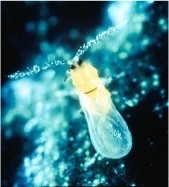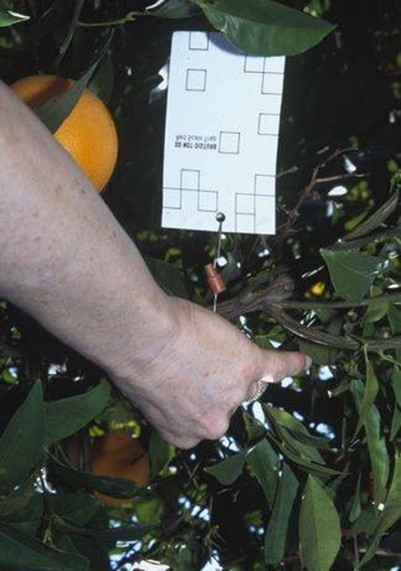
Red Scale Alert
California red scale season has started in the SJV
Sandipa Gautam - Citrus IPM Advisor
Based on traps placed at LREC citrus blocks, California red scale season began with Biofix on March 10. Pest Control Advisors in Kern, Tulare, and Fresno County reported that they have seen activity in the week of March 10.
Figure 1. California red scale male. Note: feathery antennae and brown band through the waist.
What is CRS Biofix?
CRS Biofix is the start of California red scale activity for this season. As weather warms up and heat units are accumulated above the lower developmental threshold of this insects, overwintering females start producing crawlers which develop. Males' complete development and fly to find third instar females to mate. Mated females then produce crawlers which is the First Generation of Crawlers, observed 550-degree days after the biofix.
What do males on the trap cards mean for management?
Pest control advisors have long used pheromone cards to monitor males and degree days to predict successive life event (crawler emergence) for timely management of CRS. Trap numbers may be different depending on the management choice.
Figure 2. Trap with pheromone placed within an arm's length inside the tree canopy. For assessment, count number of males within square box and multiply by 5.
- IGRs and Mating Disruption – few male scales may be on the cards as these two options affect males more than it does females. You may have lower males on card but have high CRS populations.
- Aphytis and Movento – Aphytis targets third instar females, thus affecting females more than it does males. Also, Movento controls CRS on twigs but not on wood. If Aphytis or Movento or both are used, you may see higher male numbers. If Movento was used, check the inner canopy branches, top of the tree for CRS patches.
Citrus entomology group will monitor degree days for four counties and update it biweekly on ucanr website https://lrec.ucanr.edu/Citrus_IPM/Degree_Days/.
Management is targeted at 1st and 2nd generations as the crawlers are emerging. Based on previous years, first generation crawler emergence occurs around 2nd/3rd week of May. As the degree day accumulation is temperature dependent, monitoring is critical to predict accurately.
Stay tuned for updates.


